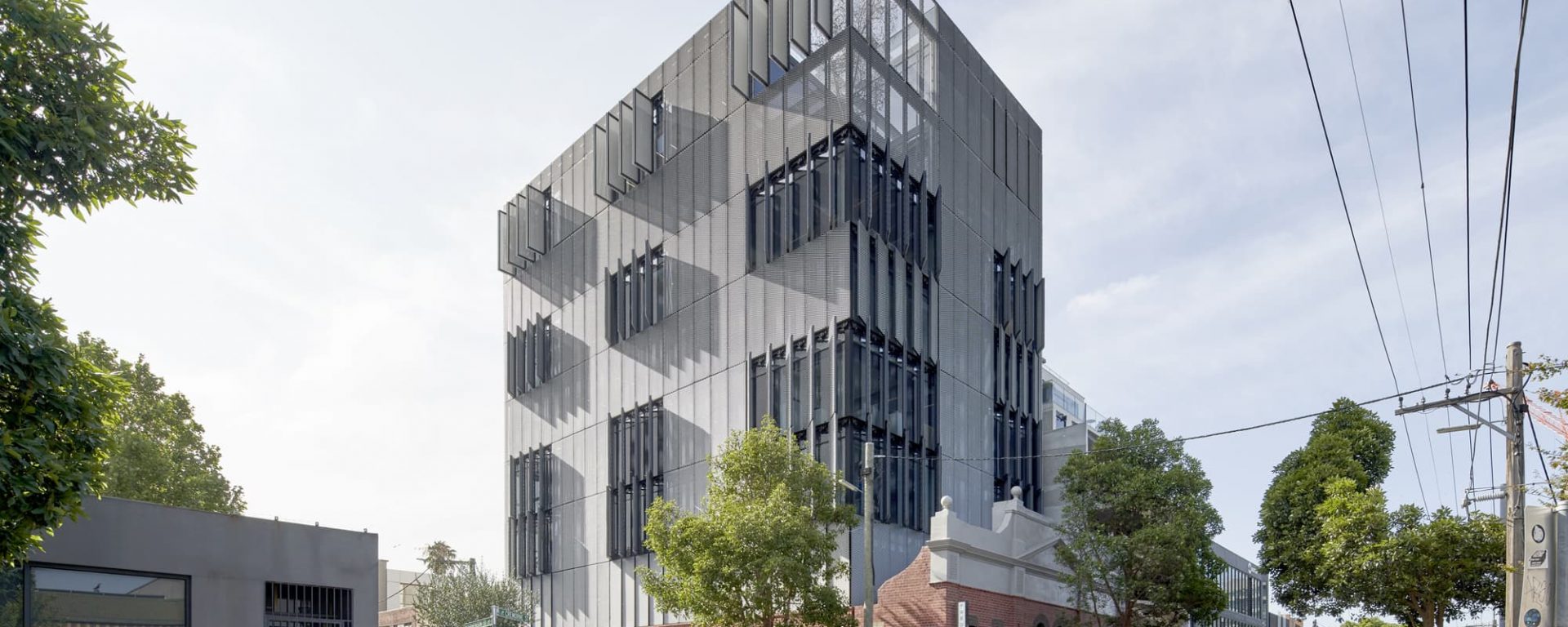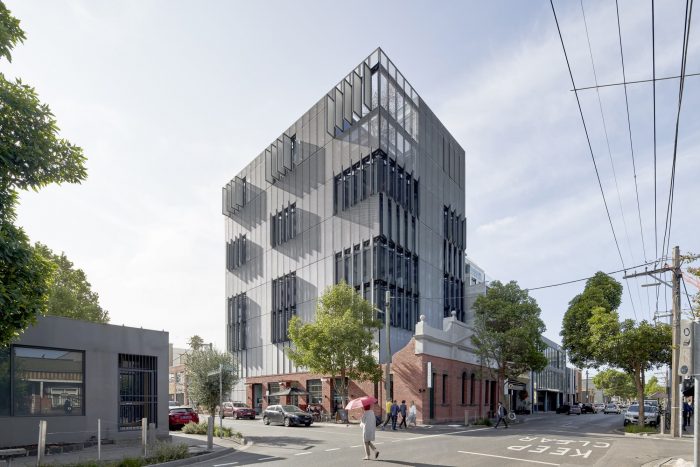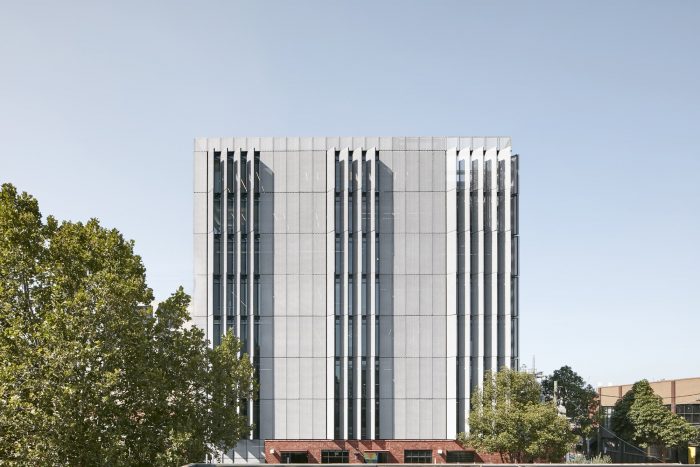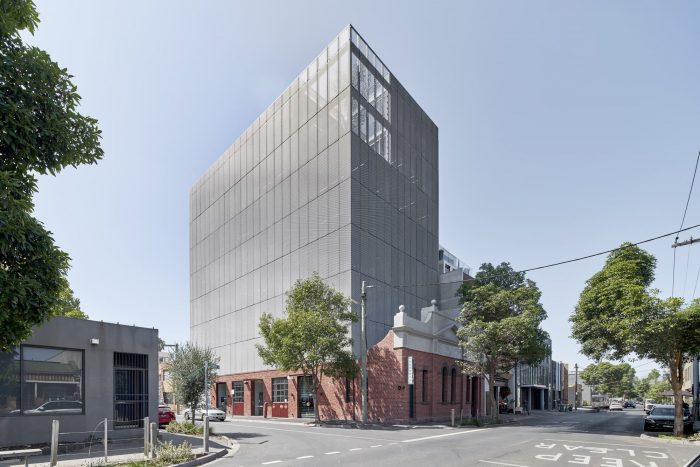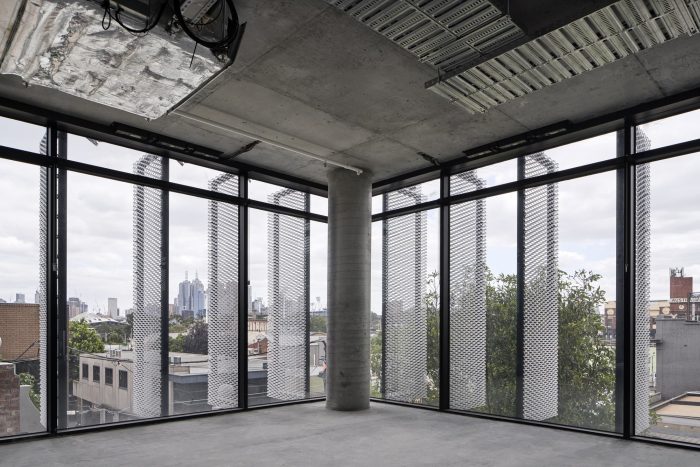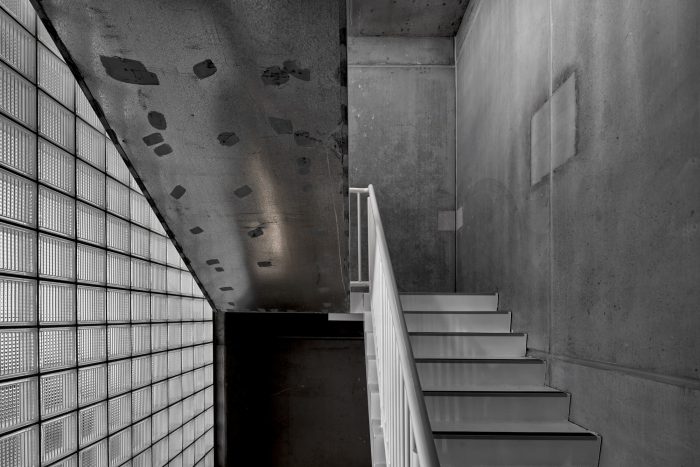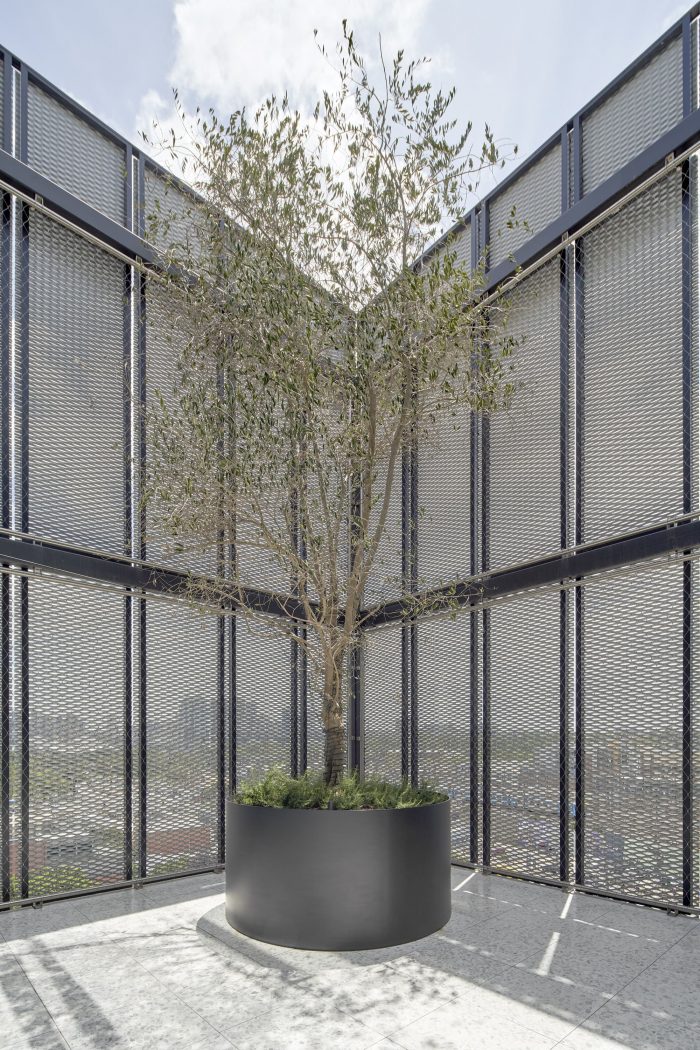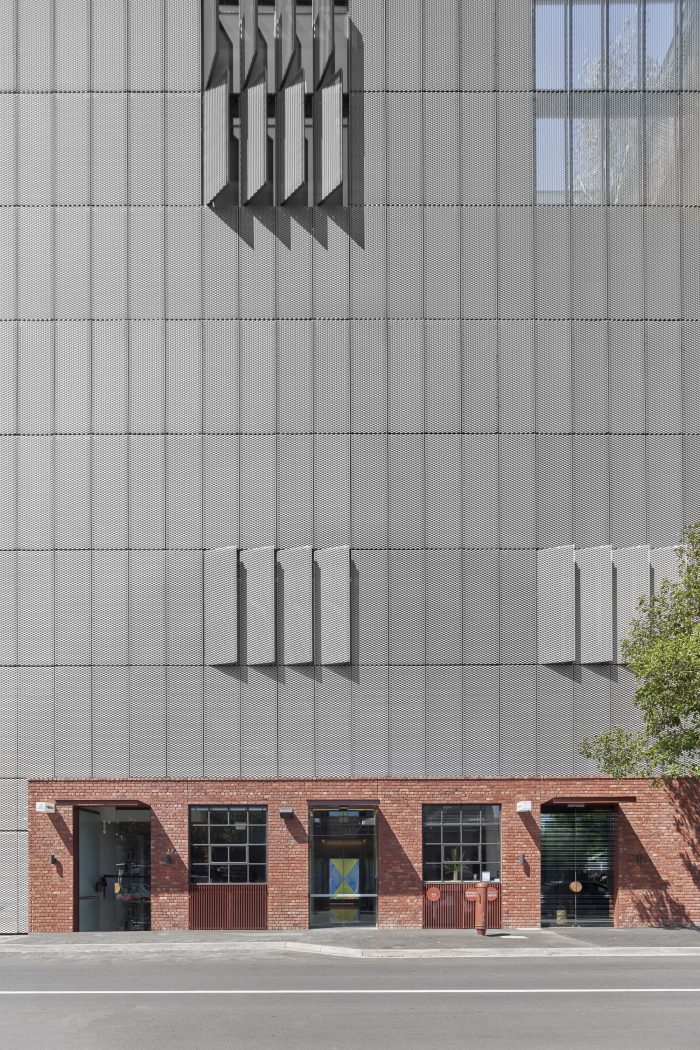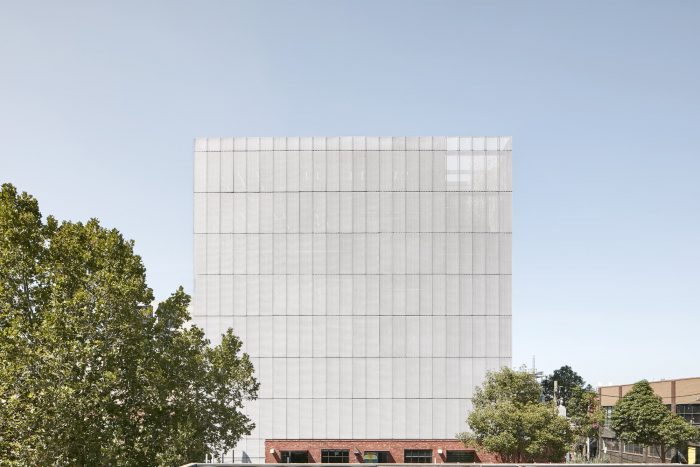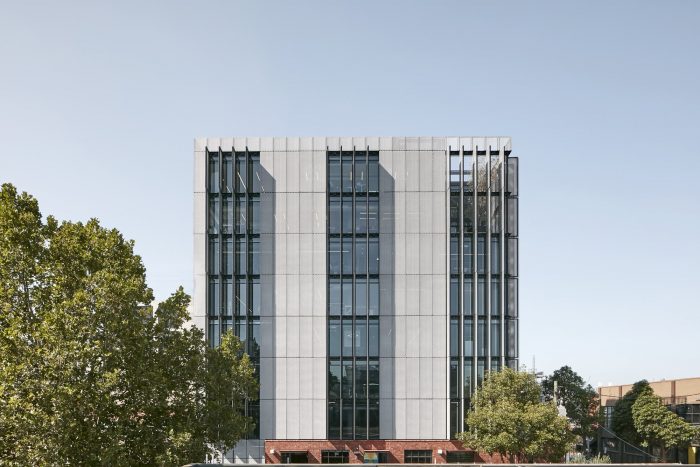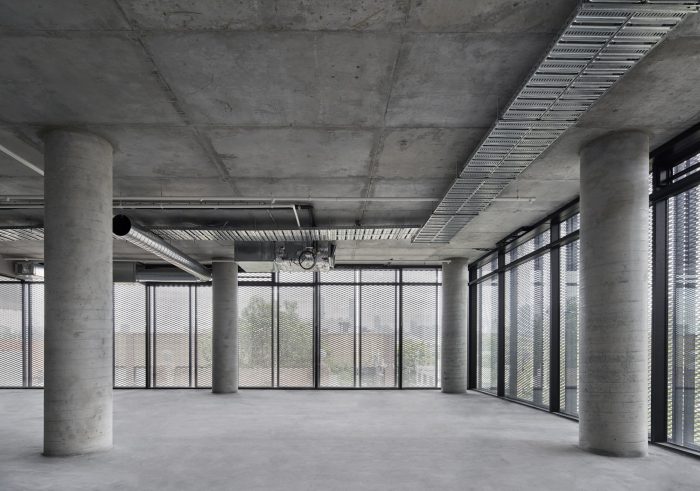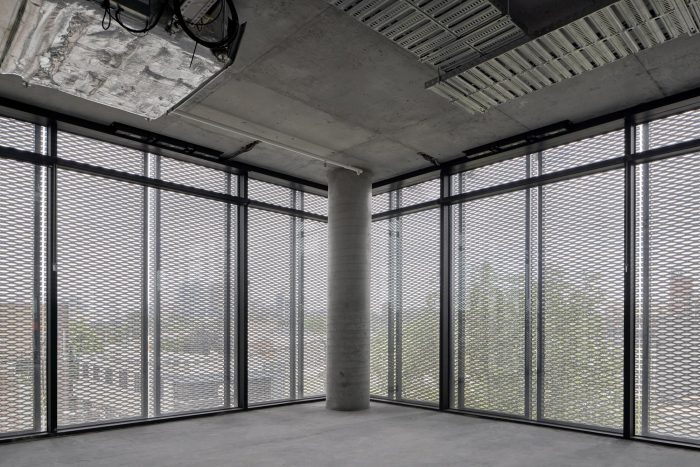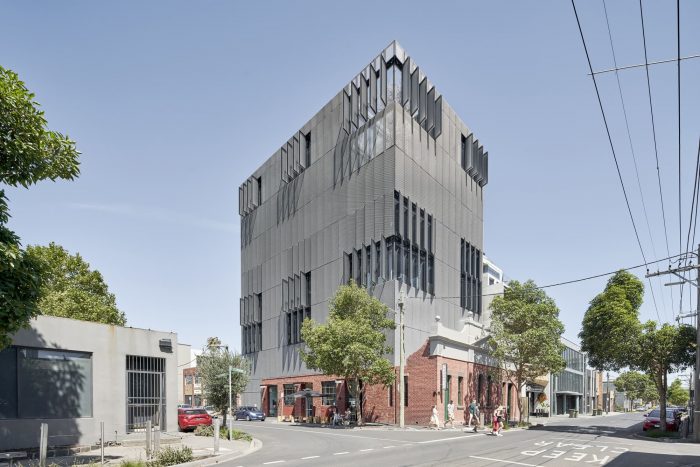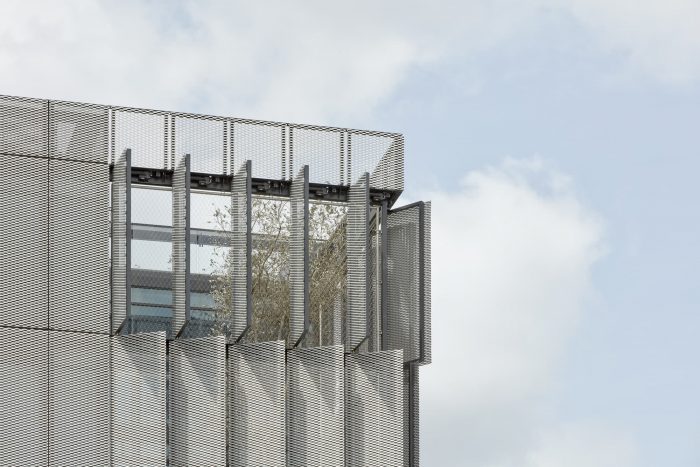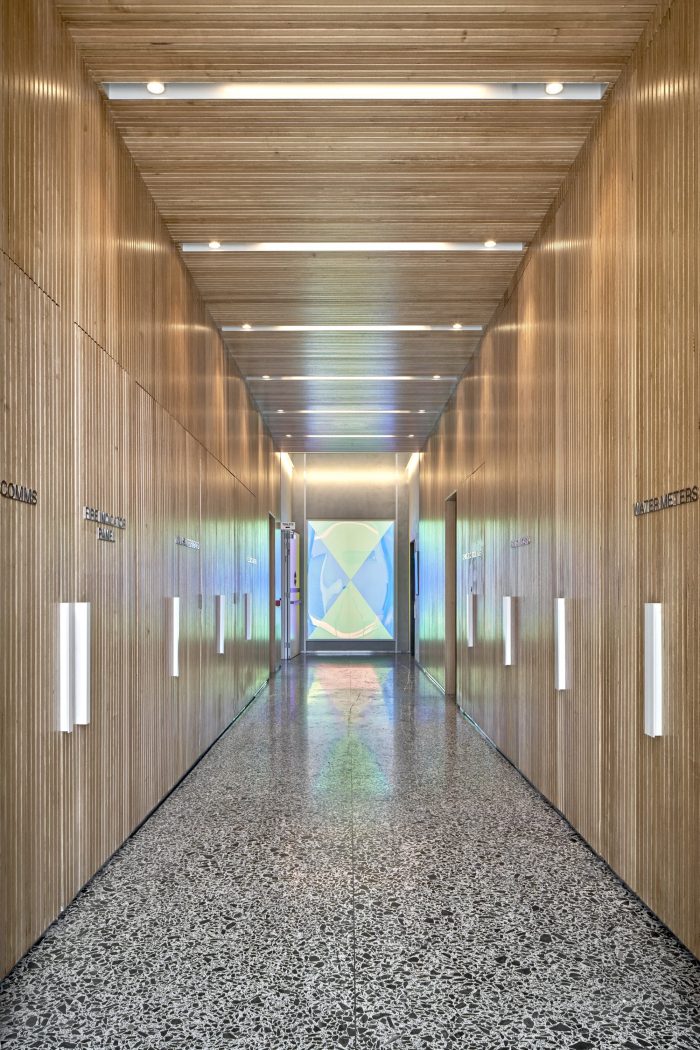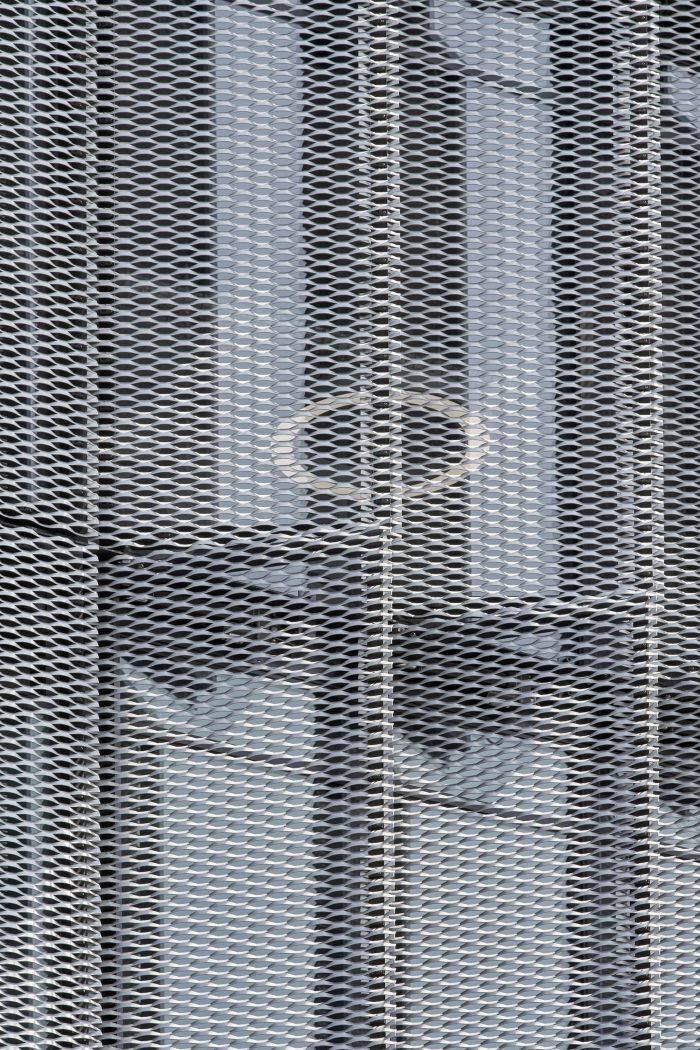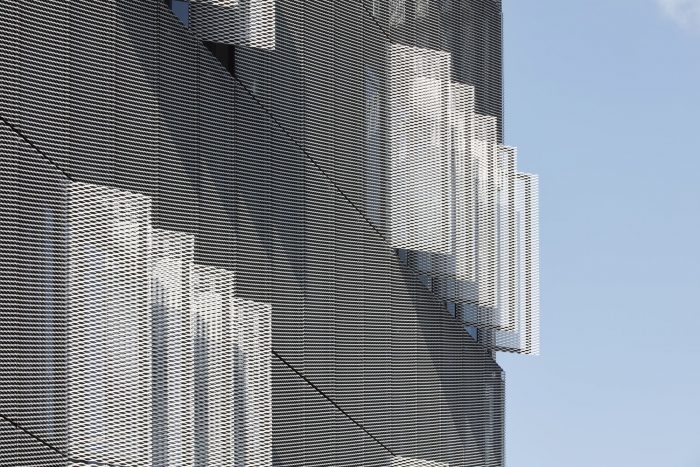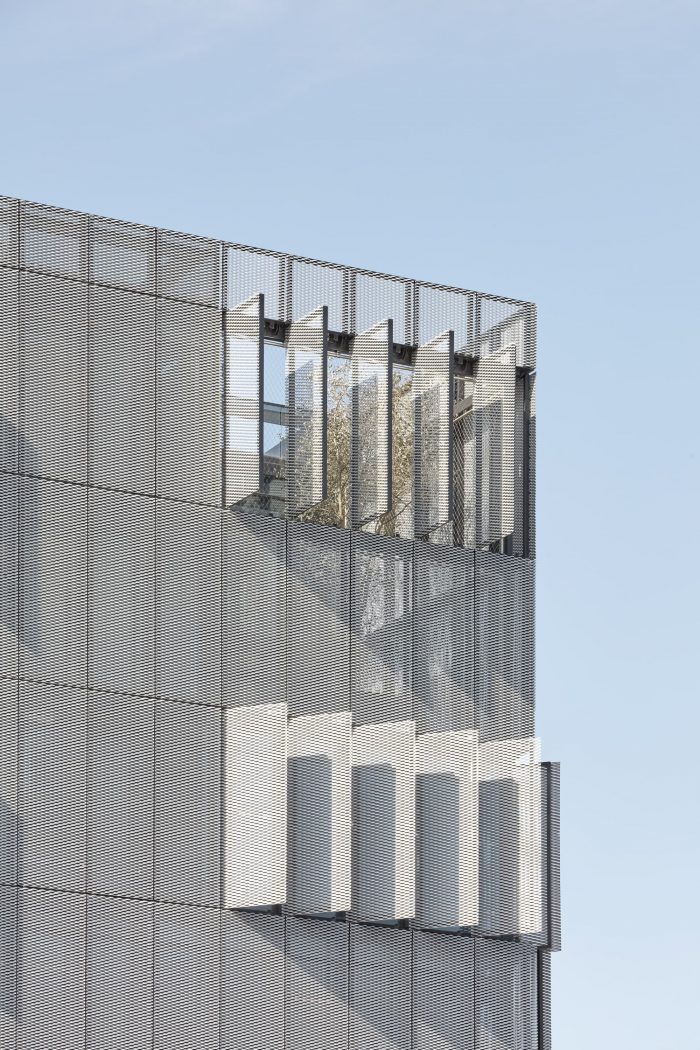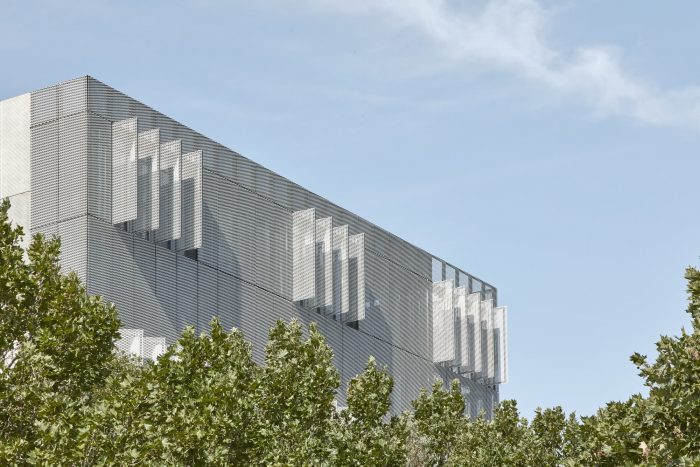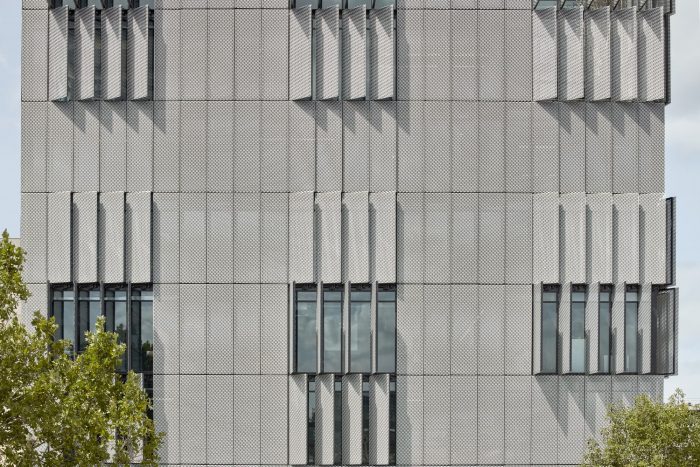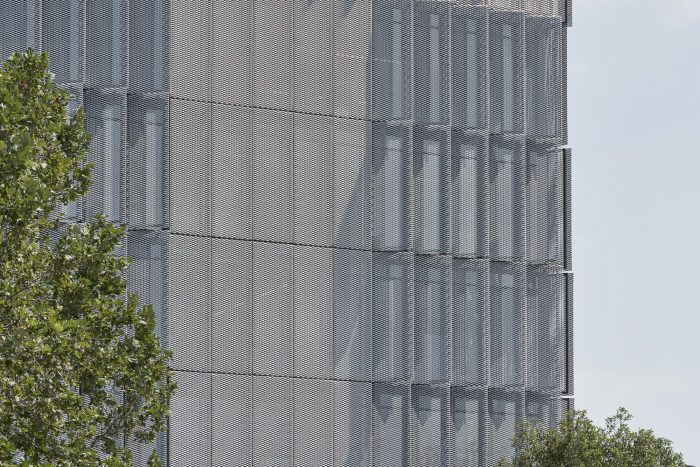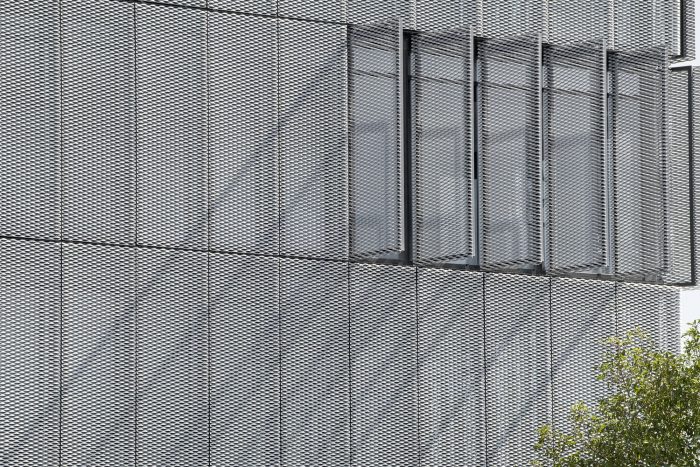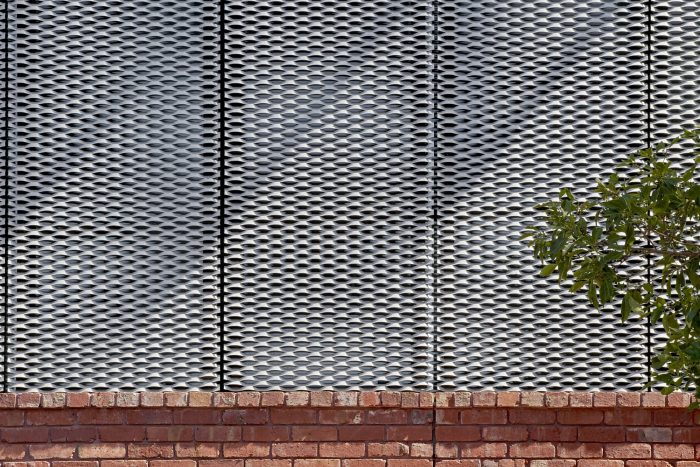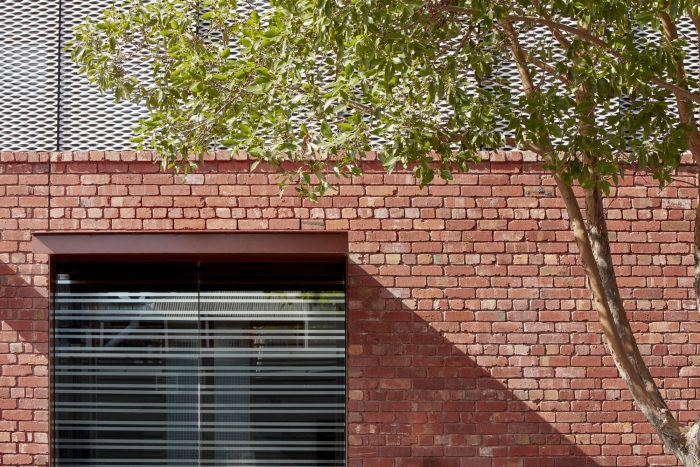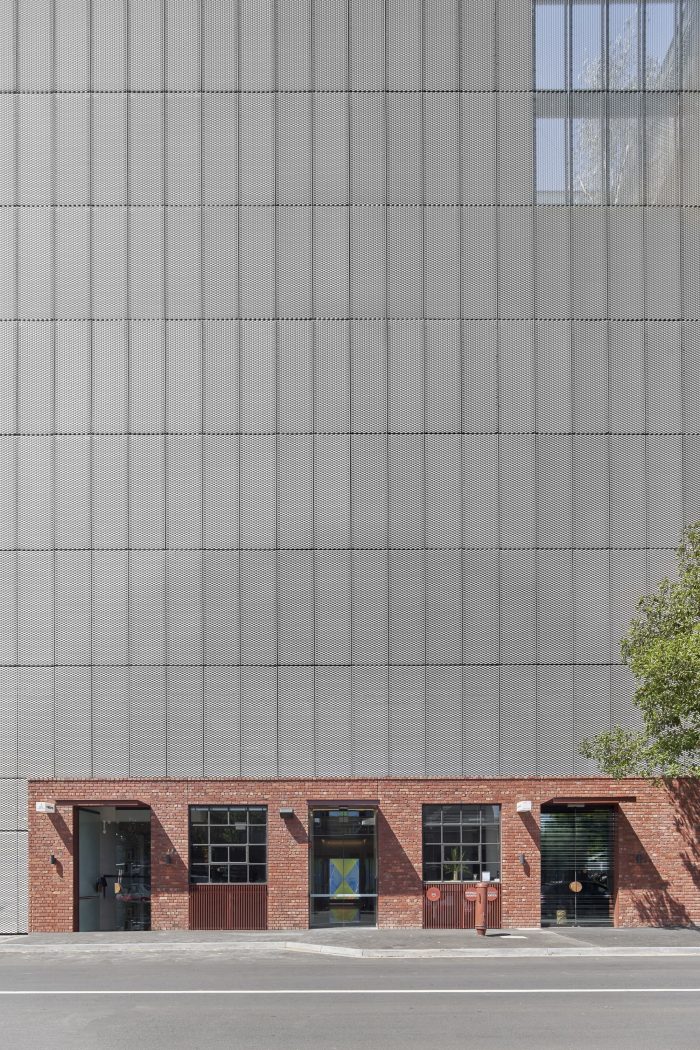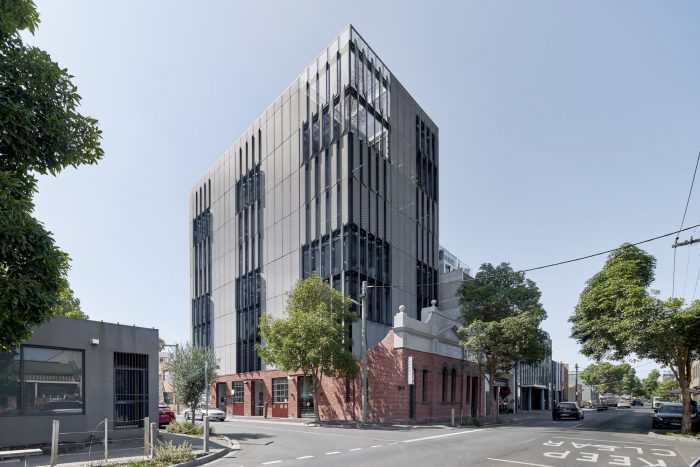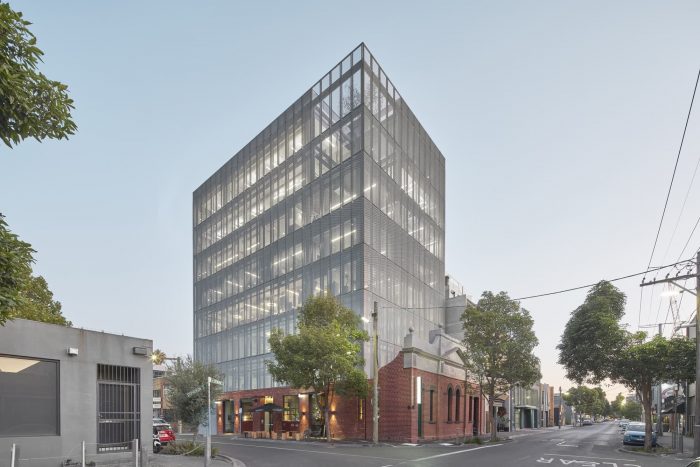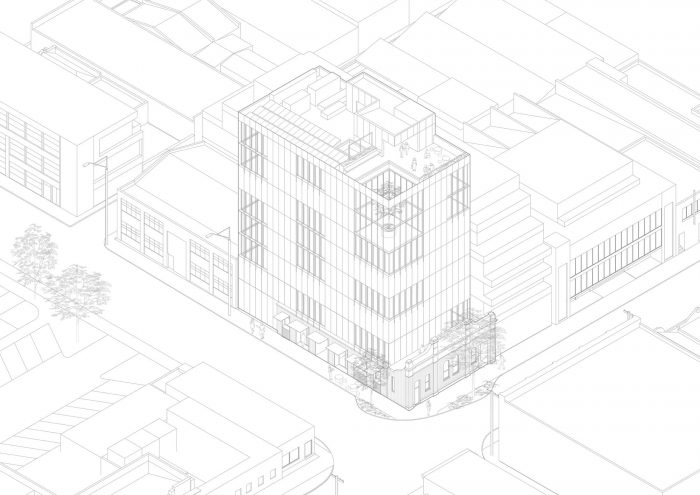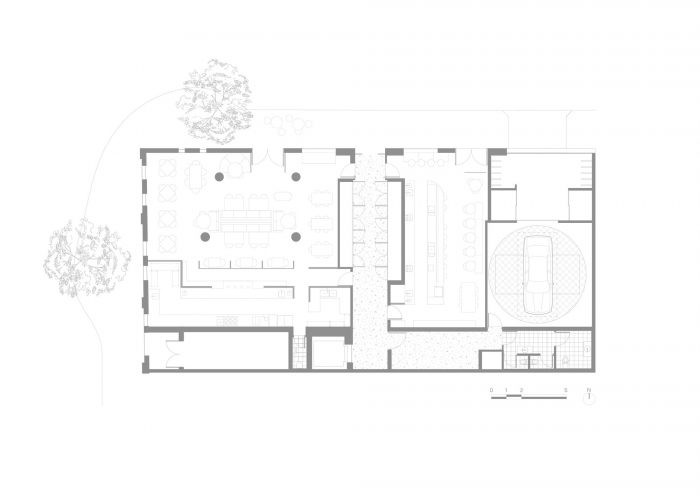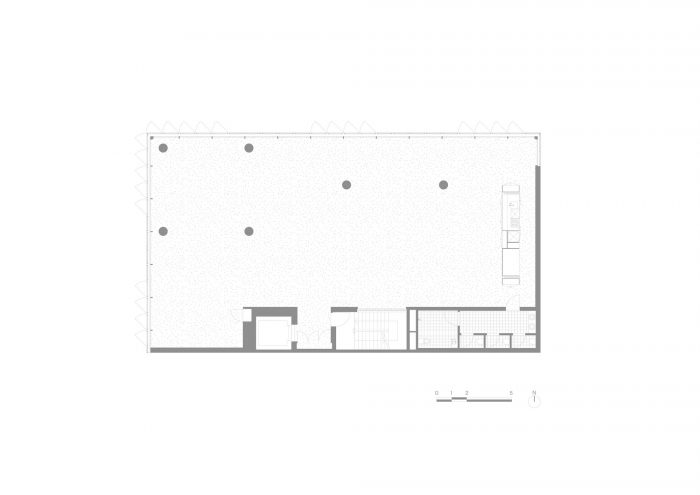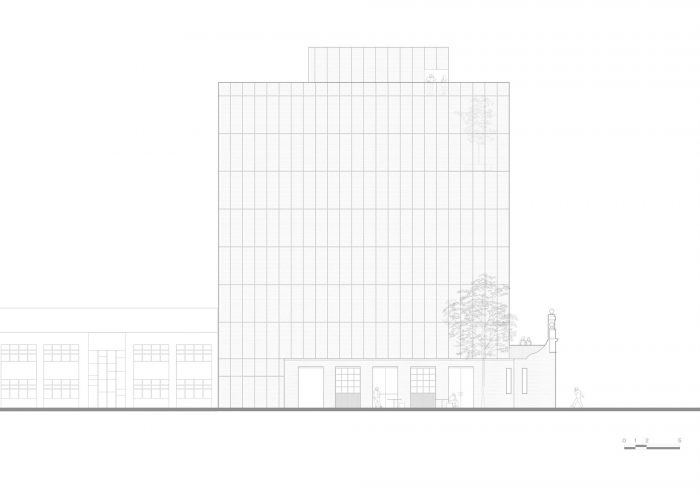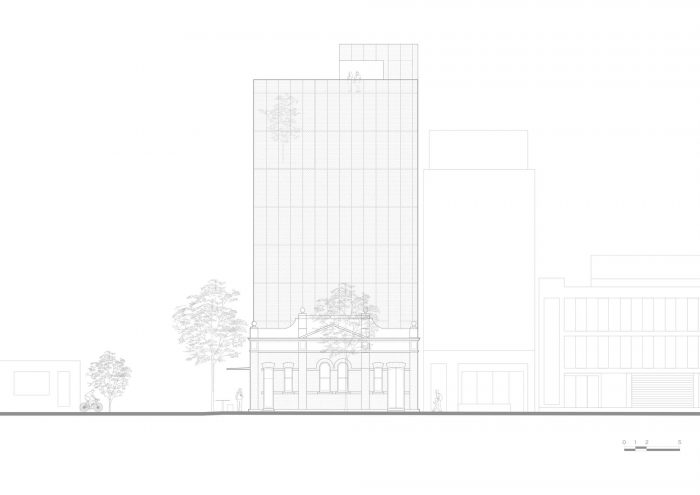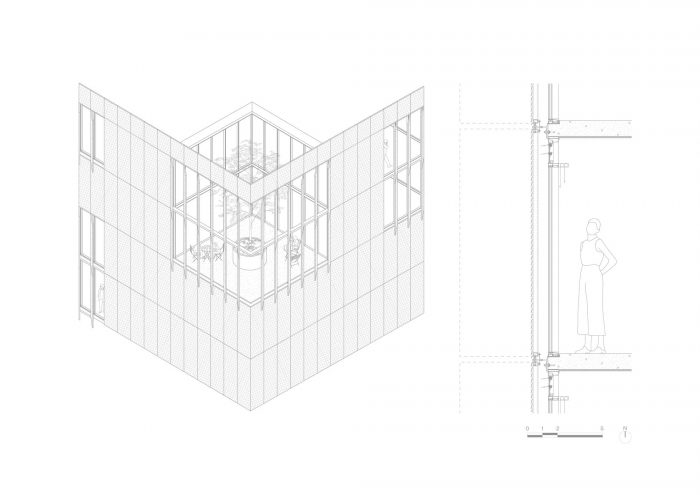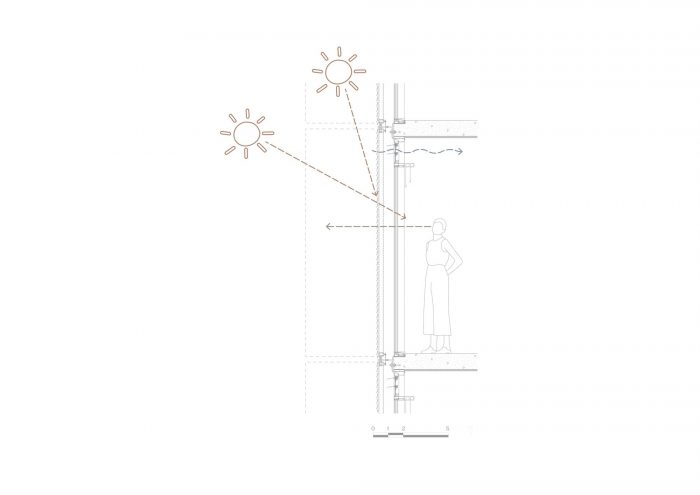在墨尔本多变的气候下,Fieldwork设计的Cremorne街9号将一个具有历史意义的工厂用地与一个新的、可持续设计的办公楼结合起来,以满足建筑商Cobild的总部。新建筑建在库林民族Wurundjeri人的传统土地上,位于城市边缘的狭小角落里,是根据澳大利亚的条件精心设计的。该建筑对不断变化的环境作出了动态反应,同时发挥了角落 “书架 “的作用,标志着通往克雷莫恩区的门户。
Dynamically shaped by Melbourne’s changeable climate, 9 Cremorne St by Fieldwork binds a historically significant factory site with a new, sustainably designed office building, accommodating builder, Cobild’s, headquarters. Built on the traditional land of the Wurundjeri People of the Kulin Nation and situated on a tight city fringe corner site, the new addition is thoughtfully designed for Australian conditions. The building dynamically responds to the changing environment, while playing the role of a corner ‘bookend’, marking the gateway to the Cremorne precinct.
作为注重细节的 “大画面 “建筑商,客户寻求一个能展示其品牌和能力的大本营。在多年的项目合作中,Fieldwork对Cobild非常熟悉,这使得设计团队能够开发出一个响应式的解决方案,突破了设计方案的界限。”我们希望建筑能够活生生地表达出Cobild所代表的东西、他们的技能和高水平的工艺,”Fieldwork的联合总监Joachim ‘Quino’ Holland说。为此,Fieldwork试图通过引入创新的 “第二层 “可操作屏幕来挑战 “玻璃盒 “办公建筑的现状。该表皮由定制的膨胀铝网构成,大大减少了热负荷和建筑的板对板玻璃幕墙上的眩光,使用户能够根据阳光、自然通风、视野、眩光和温度来定制建筑围护结构。
As ‘big-picture’ builders with an eye for detail, the client sought a home base that would showcase their brand and capabilities. Fieldwork’s familiarity with Cobild, established over years of project collaborations, allowed the design team to develop a responsive solution that pushed the boundaries of the brief. “We wanted the building to be a living, breathing expression of what Cobild stand for, their skillset and high level of craft,” says Joachim ‘Quino’ Holland, Co-Director of Fieldwork. To this end, Fieldwork sought to challenge the status quo of ‘glass box’ office buildings, by introducing an innovative ‘second skin’ of operable screens. Constructed from bespoke, expanded aluminum mesh, this skin significantly reduces heat load and glare on the building’s slab-to-slab glass façade and enables occupants to customize the building envelope in response to sunlight, natural ventilation, views, glare, and temperature.
网眼是专门用来帮助创建一个微型遮阳板的表面,以保护人们免受北部和西部的严酷阳光的影响,同时还能让人们看到风景。在不断变化的光线下,”阳极氧化的外墙创造了一种短暂的效果–在地面上是一个不断变化的幕布背景,在夜间是一个美丽的半透明的遗产体验,”Quino说。在工厂外墙触感温暖的背后,建筑强有力的元素形式在视觉上与遗产结构截然不同–敏感地从具有建筑意义的西侧外墙后退,紧紧地依偎在北侧外墙的简单细节后面。
The mesh was chosen specifically to help create a surface of micro sunshades that provide protection from the harsh northern and western sun, while still allowing views through. Enlivened by changing light qualities, “the anodized façade creates an ephemeral effect – a shifting curtain backdrop to the heritage experience at ground level, with a beautiful translucency at night,” reflects Quino. Carefully sleeved behind the tactile warmth of the factory façade, the building’s strong, elemental form is visually distinct from the heritage fabric – sensitively set back from the architecturally significant western façade and nestled closely behind the simple detailing of the northern façade.
建筑的一角通过插入一个露台和一棵成熟的橄榄树而得到强调;这是对Cobild的董事Coby和Rotem Rotenberg的以色列遗产的参考。在这里,网屏创造了一个可渗透的面纱,暗示了外面的活动,同时维护了建筑的纯洁、柏拉图式的几何形状。在下面,Fieldwork以敏感的方式处理原始的遗产结构。在与Bryce Raworth Heritage的协商下,西面的立面被小心翼翼地恢复到以前的光辉,而结构上比较简单的北面则被拆除,用翻新的钢窗和原砖重建。
The corner of the building is emphasized with the insertion of a terrace and a mature olive tree; a reference to the Israeli heritage of Cobild’s Directors, Coby and Rotem Rotenberg. Here, the mesh screens create a permeable veil that hints at the activities beyond, while upholding the building’s pure, platonic geometry. Below, Fieldwork approached the original heritage fabric with sensitivity. In consultation with Bryce Raworth Heritage, the western façade was carefully restored to its former glory, while the simpler northern façade, which was not structurally sound, was demolished and rebuilt using refurbished steel windows and original brick.
红色的砂浆与耙状的接头巧妙地区分了原始和重建的砖砌部分,而现有的落水管凹槽被重新加工成一个阴影间隙,进一步衔接了交界处。”我们想向敏锐的眼睛展示原始建筑和重建建筑的分界,”Quino说。建筑的网状立面在停车场入口的位置下降,与建筑无缝结合,而砖块立面的伸缩连接处与上面的网状板立面仔细对齐。这些精致的细节产生了一个专业的建筑作品。
Red mortar with a raked joint subtly differentiates the original and rebuilt sections of brickwork, while an existing downpipe recess is reworked as a shadow gap, further articulating the junction. “We wanted to show, to the keen eye, the division of original and reconstructed architecture,” reflects Quino. The building’s mesh façade drops down in the location of the carpark entry to seamlessly integrate with the architecture, while expansion joins in the brick façade are carefully aligned to the mesh panels facade above. These refined details produce an expertly crafted piece of architecture.
Cobild占据了大楼的前三层,提供了墨尔本城市天际线的壮丽景色,当屏幕关闭时,会有柔和的过滤效果。每个屏幕都装有一个电子致动器,在高温或大风的情况下,风和温度传感器将自动关闭屏幕。在内部,建筑的全高玻璃包含了自然通风的百叶窗,用户可以独立于屏幕打开,”允许每层楼在一天结束时清除热量,并在凉爽的变化到来时交叉通风,”Quino解释说。
Cobild occupies the building’s top three floors, which offer commanding views across Melbourne’s city skyline, softly filtered when the screens are closed. Each screen is fitted with an electronic actuator, with wind and temperature sensors overriding automatically closing the screens in high heat or wind conditions. Internally, the building’s full-height glazing contains louvers for natural ventilation which occupants can open independently of the screens, “allowing each floor to purge heat at the end of the day and cross-ventilate when a cool change arrives,” explains Quino.
垂直庭院,跨越两层楼的空隙,将工作场所延伸到一系列的景观露台。周边用精细的不锈钢网罩住,减少了对栏杆的需求,并允许不间断地看到城市和天空。Cobild总监Coby Rotenberg说,一个额外的屋顶娱乐空间营造了一个繁荣的社区氛围,满足了客户对 “健康、快乐和高效的工作文化 “的渴望。
The vertical courtyard, scaling a two-story void, extends the workplace into a series of landscaped terraces. The perimeter is shrouded with a fine, stainless-steel mesh, mitigating the need for balustrades and allowing for uninterrupted views to the city and sky. An additional rooftop entertainment space fosters a thriving community atmosphere, addressing the client’s desire for a “healthy, happy, and productive work culture,” says Coby Rotenberg, Director of Cobild.
除了建筑的可操作外墙,该项目还获得了五星级绿色之星的评级,并采取了城市和社会可持续发展措施。停车场的数量比法定要求减少了78%,在全自动汽车堆垛机内提供电子充电设施,以支持低排放车辆,同时提供终点设施,以促进主动运输方式,减少温室气体排放。每个办公室租户都有水和能源使用情况的综合数字显示,每月都有消费趋势报告。屋顶的太阳能光伏板为外部屏幕的运行和公共区域的能源需求做出了贡献。景观区被提供给三个露台,在一个缺乏当地户外设施的地区创造绿色空间,并在现场提供水储存和过滤。
In addition to the building’s operable façade, the project achieves a 5 Star Greenstar rating together with urban and social sustainability measures. Carparking numbers are reduced from statutory requirements by 78 percent and e-charging facilities within the fully automated car stacker are provided to support low-emission vehicles, alongside end-of-trip facilities to promote active transport methods and reduce greenhouse emissions. Comprehensive digital displays of water and energy use are provided for each office tenancy which produces monthly reports on consumption trends. Solar photovoltaic panels on the roof contribute to the operation of the external screens and common area energy demands. Landscape zones are provided to three terraces, creating green space in an area deficient of local outdoor amenities, with water storage and filtration provided on site.
“我们对这个结果非常满意,”Rotem说。”营造一个良好的工作环境对我们的团队至关重要,推动高质量的设计使我们能够获得额外的两层楼的批准,便于将来扩展业务的能力。独特的外墙屏幕使我们的团队能够在一天中调整他们的工作场所–我们喜欢看它的运作。” 其结果是对地方的创新和敏感的反应;一个高度解决的建筑成果,在同等程度上庆祝其背景和合作者。
“We could not be happier with the outcome,” reflects Rotem. “Fostering a great working environment is critical to our team and driving a quality design has allowed us to gain approval for an additional two storeys, facilitating an ability to expand the business into the future. The unique façade screens allow our team to adapt their workplace throughout the day — we love watching it in action.” The result is an innovative and sensitive response to place; a highly resolved built outcome that celebrates its context and collaborators in equal measure.
Architects: Fieldwork
Year : 2020
Photographs :Peter Clarke
Builder : Cobild
Heritage Consultant : Bryce Raworth Heritage
City : Cremorne
Country : Australia

